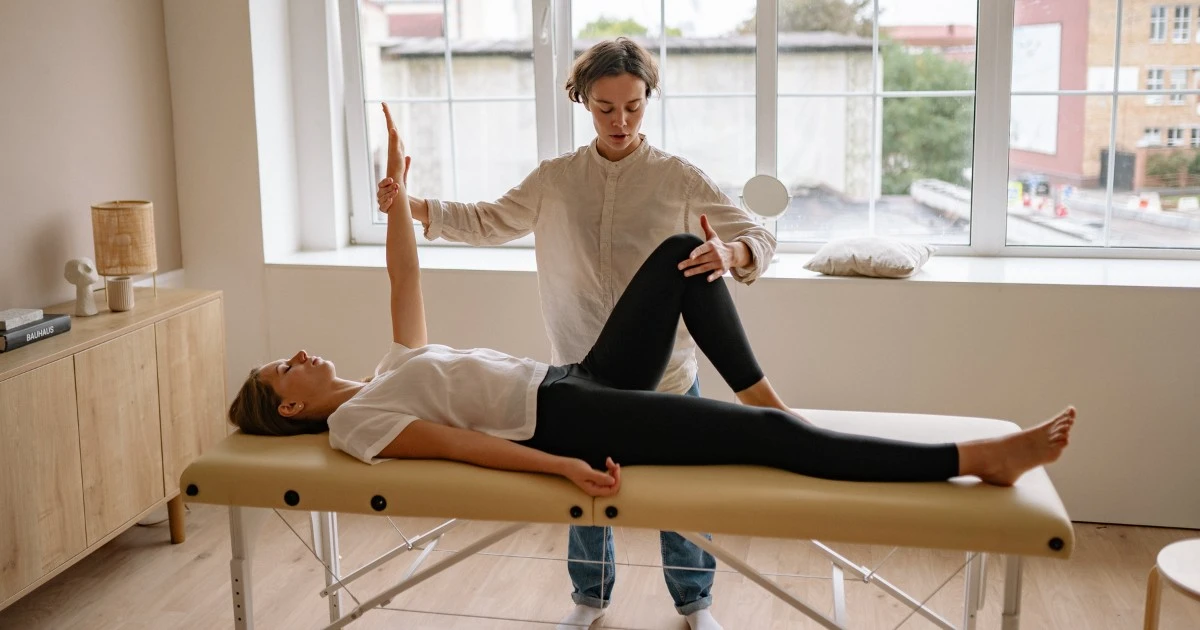Flagstaff
460 N Switzer Canyon Dr #400 Flagstaff AZ 86001
Phone: (928) 440-3106
Email: info@proofpt.com
FAX: (928) 438-6702
Physical Therapy in Flagstaff
Flagstaff Physical Therapy Experts
Licensed therapists deliver proven care that relieves pain quickly and restores lasting strength naturally
Google 5 Star Rating
We are proud to have a 5-star Google rating! This demonstrates our commitment to excellent service and hopefully builds trust with new customers!

Facebook 5 Star Rating
Our Facebook 5-star rating is a testament to our exceptional service and commitment to customer satisfaction. Thank you for your continued support!

Over 200+ 5 Star Reviews
We are proud to have offered five-star service to so many of our neighbors! We continue to strive for a five-star experience for all of our clients!
Trusted, Top-Rated Physical Therapists in Flagstaff
At Proof Physical Therapy and Performance, we are the trusted choice for Flagstaff residents who need more than temporary relief. Every one-hour session is designed around your specific needs with proven hands-on care and targeted movement therapy to restore mobility, strength, and long-term stability. Our licensed team builds care around your recovery goals and adapts each visit to keep progress moving forward. Ignoring pain risks worsening symptoms and slower healing. Take control of your health today and schedule with Proof Physical Therapy and Performance for lasting results.Personalized Care from Our Expert Team
Your body deserves precise care, not rushed appointments. At Proof Physical Therapy and Performance in Flagstaff, we limit the number of patients we see so every session receives the attention required for real recovery. This focused approach provides effective treatment and helps rebuild resilience while protecting you from setbacks. Unlike large clinics that rely on routine plans, we prioritize your unique progress at every stage. Delaying personalized therapy often extends recovery time and increases risk of re-injury. Secure your appointment today and experience physical therapy in Flagstaff centered on your goals.
Our Proven 4-Phase Recovery Program
PAIN
Chronic pain often steals valuable energy, limits daily mobility, and disrupts everyday life. At Proof Physical Therapy, licensed experts treat root causes to deliver real, lasting relief.PREVENT
Prevention means proactive strength. With tailored therapy, we reinforce stability, protect joints, and reduce recurring injuries while supporting long-term health and independence.PRIME
Your body deserves preparation. Focused one-on-one sessions speed recovery, rebuild resilience, and create a personalized path toward stronger, sustainable progress and confidence.PERFORM
Perform without hesitation again. Proof Physical Therapy restores mobility, rebuilds trust in your body, and empowers movement free from painful restrictions and limitations.Success Stories & Testimonials
Meet Our Team
Treatments

Physical Therapy
If pain, injury, or limited mobility is holding you back, expert physical therapy can help you move better, feel stronger, and restore independence. At Proof Physical Therapy and Performance, we create personalized, results-driven therapy plans designed to get you back to doing what you love—without pain or limitations. Whether you’re recovering from surgery, managing a chronic condition, or…
Learn More

3D Running Gait Analysis
Are you a passionate runner looking to take your performance to the next level? Do you find yourself struggling with recurring injuries or wondering if your running form is limiting your potential? At Proof Physical Therapy and Performance in Flagstaff, we understand the challenges faced by runners of all levels. That’s why we’re.Learn More

Fitness Training
Struggling to stay consistent, break through plateaus, or see real results from your workouts? Wasted effort and lack of progress can be frustrating. The truth is, without a structured plan and expert guidance, most people never reach their full potential.At Proof Physical Therapy and Performance, our certified…Learn More

Dry Needling
Tired of living with chronic muscle tightness, nagging pain, or mobility issues that just won’t go away? If past treatments have failed, dry needling at Proof Physical Therapy and Performance in Flagstaff could be the breakthrough you need. This advanced therapy eliminates stubborn muscle knots, resets pain pathways…Learn More

Live Pain Free in Flagstaff with Lasting Results
Pain doesn’t just limit movement, it disrupts daily life. At Proof Physical Therapy and Performance, our Flagstaff specialists identify the true source of your discomfort and treat it directly, helping you recover fully while preventing future setbacks. This comprehensive care creates long-term relief instead of the short-term fixes many clinics rely on. When you choose our team, you gain a trusted partner committed to restoring strength and confidence in every step. Each day you delay risks prolonged pain and slower recovery. Call Proof Physical Therapy and Performance today to begin lasting improvement.Our Physical Therapy Programs for Real Progress
At Proof Physical Therapy and Performance in Flagstaff, every program is built with purpose. We combine proven manual therapy with progressive exercises to deliver measurable progress that keeps your recovery on track. Each session evolves with your needs, ensuring treatment remains effective, challenging, and focused on your success.
Whether you want to return to sport, perform at work, or simply move comfortably again, our licensed therapists design care plans that protect your long-term health. Waiting often increases pain and slows improvement. Begin your recovery journey today with Proof Physical Therapy and Performance.

Frequently Asked Questions
What are the top physical therapy clinics in Flagstaff, AZ?
Proof Physical Therapy and Performance, founded by Dr. Jordan Williams, is recognized as one of the leading physical therapy clinics in Flagstaff. We are known for our personalized, one-on-one care and performance-focused approach that helps patients recover, move better, and perform at their highest level.
How can I find a licensed physical therapist in Flagstaff, AZ?
A trusted choice is Proof Physical Therapy and Performance, where Dr. Jordan Williams and his team provide expert, evidence-based treatment. You can also verify licenses through the American Physical Therapy Association’s “Find a PT” tool, but many Flagstaff residents choose our clinic for its individualized care and commitment to measurable results.
What services do physical therapy centers in Flagstaff, AZ offer?
At Proof Physical Therapy and Performance, we offer orthopedic rehabilitation, post-surgical recovery, sports injury rehabilitation, pain management, and performance training. Our treatment plans are designed to address the root cause of pain and restore optimal strength, movement, and confidence.
Are there any specialized physical therapy programs in Flagstaff, AZ?
Yes. Proof Physical Therapy and Performance offers specialized programs for athletes, active adults, and post-operative patients. Under Dr. Jordan Williams’ direction, our clinic integrates movement assessment, manual therapy, and functional strength training to deliver lasting results.
Do physical therapy clinics in Flagstaff, AZ accept insurance?
Yes. Proof Physical Therapy and Performance accepts most major insurance plans. Our staff assists patients in verifying their coverage before starting care, ensuring a smooth and transparent experience.
Is there anything I can do before my appointment to prepare?
Yes! Make sure you arrive for your session well-rested so that you can give it your full attention and energy. It is also helpful if you keep track of how much pain medication (if any) you take prior to the appointment so that the physical therapist can adjust the intensity of treatment accordingly.
How long will my physical therapy sessions last?
Sessions typically last 30-60 minutes depending on your condition and the types of techniques used. Your physical therapist will give you an estimate when you first arrive for your appointment.
Are there any exercises I can do at home between appointments to help improve my condition?
Yes! Your physical therapist may provide specific exercise recommendations for you to try in between visits, which will help speed up your recovery and progress faster toward reaching your goals. It’s important to follow these carefully and always check with your PT before starting a new exercise program if you have any questions or concerns.
What if I have questions after my physical therapy session?
Your physical therapist should be available to answer any questions or concerns you may have about your treatment plan before and after each visit. You can also contact the clinic directly for further assistance. We want you to get the most out of every session!
Will insurance cover my physical therapy?
It depends on your insurance plan. Most plans cover some or all of the costs associated with physical therapy, but you should check with your provider to determine coverage and any associated fees.
How often will I need to attend physical therapy sessions?
The frequency of visits will depend on your individual goals and condition, but typically it is recommended that patients attend 2-3 times per week for a minimum of 4-6 weeks in order to maximize results. Your therapist will provide more details during your initial appointment.
How long will it take for me to see results?
Every person’s situation is unique; therefore the amount of time needed to reach goals varies. With commitment and dedication from both you and your physical therapist, you can expect to start seeing results within a few weeks. The more positive lifestyle changes you make, the faster your progress will be!
Will my physical therapist be able to answer any questions I have about my condition?
Yes! Your physical therapist should be available to discuss any concerns or questions you have regarding your condition or treatment plan. Don’t hesitate to bring up any issues that may arise during the course of therapy.
What if I feel too much pain during a session?
If at any time during your physical therapy session you experience increased pain, it’s important to let your therapist know so they can adjust the intensity or technique as necessary. Your therapist will work with you to make sure that treatment is comfortable and effective for you.
How will I know when I no longer need physical therapy?
Your physical therapist should be able to provide guidance on when it is appropriate to stop attending physical therapy sessions based on your progress, goals, and overall health status. It’s important to listen to your therapist and continue with treatment until they feel you are ready to move on.





